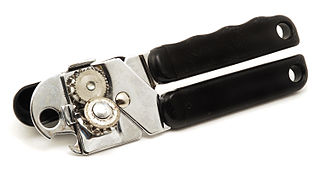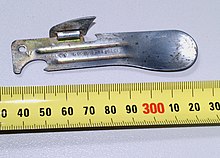
The Meal, Ready-to-Eat (MRE) is a self-contained individual United States military ration used by the United States Armed Forces and Department of Defense. It is intended for use by American service members in combat or field conditions where other food is not available. MREs have also been distributed to civilians as humanitarian daily rations during natural disasters and wars.

The C-ration was a United States military ration consisting of prepared, canned wet foods. They were intended to be served when fresh or packaged unprepared food was unavailable, and survival rations were insufficient. It was replaced by the similar Meal, Combat, Individual (MCI) in 1958; its modern successor is the Meal, Ready-to-Eat (MRE).

A can opener or tin opener is a mechanical device used to open metal tin cans. Although preservation of food using tin cans had been practiced since at least 1772 in the Netherlands, the first can openers were not patented until 1855 in England and 1858 in the United States. These early openers were basically variations of a knife, though the 1855 design continues to be produced.

The P-38 is a small can opener that was issued with canned United States military rations from its introduction in 1942 to the end of canned ration issuance in the 1980s. Originally designed for and distributed in the K-ration, it was later included in the C-ration. As of 2020, it is still in production and sold worldwide.

A mess kit is a collection of silverware and cookware designed for use by military personnel for food and military rations. They may also be used during camping and backpacking. There are many varieties of mess kits that militaries issue to their personnel that later become available to consumers.

United States military ration refers to the military rations provided to sustain United States Armed Forces service members, including field rations and garrison rations, and the military nutrition research conducted in relation to military food. U.S. military rations are often made for quick distribution, preparation, and eating in the field and tend to have long storage times in adverse conditions due to being thickly packaged or shelf-stable.

The K-ration was a United States military ration consisting of three separately boxed meal units: breakfast, dinner, and supper. It was originally intended as an individually packaged daily ration for issue to airborne troops, tank crews, motorcycle couriers, and other mobile forces for short durations.

Humanitarian daily rations (HDRs) are food rations manufactured in the United States intended to be supplied to civilians and other non-military personnel in humanitarian crises. Each is intended to serve as a single person's full daily food supply, and contains somewhat over 2,200 calories (9,200 kJ). They have shelf-lives of about 3 years, and their contents are designed to be acceptable to a variety of religious and ethnic groups. The meals cost approximately one-fifth of the cost of a Meal, Ready-to-Eat (MRE), or US$4.70 in 2012. The rations were first used in Bosnia in 1993 as part of Operation Provide Promise.

A field ration is a type of prepackaged military ration designed to be easily and quickly prepared and consumed in the field, in combat, at the front line, or where eating facilities are otherwise unavailable. Field rations are primarily used by military forces, though they are also sometimes distributed to civilians as part of humanitarian aid and emergency management. They differ from garrison rations and field kitchen provisions, which are intended for where proper meals can be supplied and prepared with relative ease and safety, such as in the rear where logistics are steady and fresh food can be supplied. They are similar to, but distinct from, other purpose-designed long-lasting types of food or rations such as emergency rations, humanitarian daily rations, and camping food.

The Individual Meal Pack or IMP is one type of field ration used by the Canadian Forces. The IMP is designed so that a continuous diet provides all the nutrition needed to sustain a service-person in the field. The IMP meets Canada's nutrition requirements, with the exception of calcium and folic acid, which are not significant if the consumption period of rations is less than 30 (consecutive) days. IMPs provide 1,200–1,400 calories (5.0–5.9 MJ) per meal.

A garrison ration is a type of military ration. Usually distinct from field rations, the term has varying meanings, but generally refers to either rations issued to personnel at a camp, installation, or other garrison; allowance allotted to personnel to purchase goods or rations sold in a garrison; the rations purchased with the aforementioned allowance; or a type of issued ration.
The 5-in-1 ration was a United States military ration issued from 1942 to the end of World War II. As its name implies, the 5-in-1 provided the needs of five soldiers in a single ration package. Procurement ended with the war, though remaining stocks were issued to troops after the war, as well as distributed as surplus in civilian feeding programs overseas. The 5-in-1 specification remained in effect after the war, and was again used in 1948 for a new field ration.

The Combat Ration One Man (CR1M) is a self-contained individual field ration in lightweight packaging procured by the Australian Defence Force for use in combat or other field conditions where organised food facilities are unavailable.

The Food Packet, Long Range Patrol was a freeze-dried dehydrated United States military ration used by the United States Armed Forces. Developed in 1964 and intended for wide adoption during the Vietnam War, its use was eventually limited to American special operations forces during long-range reconnaissance patrols, where bulky canned Meal, Combat, Individual (MCI) rations proved too heavy for extended missions on foot. The LRP had a cold-weather warfare equivalent, the Ration, Cold Weather (RCW).

The Meal, Combat, Individual (MCI) was a United States military ration of canned and preserved food, issued from 1958 to 1980. It replaced the earlier C-ration, which it was so similar to that it was often nicknamed the "C-ration", despite the term never being used officially. The MCI was eventually replaced by the Meal, Ready-to-Eat (MRE).
Digger slang, also known as ANZAC slang or Australian military slang, is Australian English slang as employed by the various Australian armed forces throughout the 20th and 21st centuries. There have been four major sources of the slang: the First World War, the Second World War, the Korean War and the Vietnam War. The name Digger slang derives from the cultural stereotype of the Digger in the First World War. Graham Seal AM, Professor of Folklore at Curtin University of Technology, calls the slang Diggerese. It is a combination of an occupational jargon and an in-group argot.
Combination eating utensils, also known as hybrid utensils, are utensils that have the qualities of other utensils combined into one. This can be done to make a more convenient, less wasteful, or more cost-efficient product. Many different types of combination utensils have been created, each designed to serve a different purpose.














